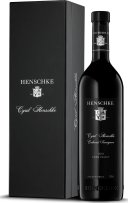Chateau Pichon-Longueville Baron Lalande Pauillac
"Chateau Pichon-Longueville Comtesse de Lalande is the sister property to Chateau Pichon-Longueville Baron, formed upon the death of Baron Joseph de Pichon Longueville in 1850. The parcel of vines we now know as Pichon Lalande were passed to the Baron’s three daughters, and today is one of the most elegant wines in the Haut Medoc. This elegance should not be confused with being underweight, as the wines have enormous richness and intensity, and age extremely well. Plantings on the large property include a blend of 61% Cabernet Sauvignon, 32% Merlot, 4% Cabernet Franc, and 3% Petit Verdot."
Mayacamas Vineyards Cabernet Sauvignon
MAYACAMAS VINEYARDS Cabernet Sauvignon, Napa Valley Not much has changed by way of production since Bob Travers started the Mayacamas estate in the early 1940s. The fruit is handpicked early, often in early September - abvs usually end up between 13 and 14 percent to preserve natural, altitude derived acidities. Fermentations occur predominantly in open-top cement vessels which were built in the 1950s, again to preserve acidities and vibrant fruit character. Extended ageing occurs exclusively in neutral oak some as old as 100 years typically for three years which allows the vineyard's expression to shine through the powerful fruit profile, while also minimising oxygenation and helping to maintain the powerful and tight tannin structure Mayacamas is so famous for. The wines then usually spend a further two years in bottle before it is ready to be released to the market. Mayacamas make wines that lie in stark contrast to the more prevalent rich, heavily oaked, high in abv, bombastic wines that are common in the Napa Valley.
Woodlands Matthew Cabernet Sauvignon
Jonata El Desafio de Jonata
Henschke Cyril Henschke Cabernet Sauvignon
Henschke's flagship Cabernet is named after the late Cyril Henschke who purchased the Eden Valley property in the 1960s. Stephen and Prue Henschke then established the vineyard with Cabernet Sauvignon, Merlot and Cabernet Franc vines which produces this intensely perfumed Cabernet. Matured in 100% new French oak for 18 months, this exceptional wine shows blackcurrant and cedar characters balanced with superb fine grained tannin.
Penfolds Bin 389 Cabernet Shiraz (6 )
Penfolds Bin 389 Cabernet Shiraz is dubbed the 'Baby Grange' for good reason, in part because components of the wine are matured in the same barrels that held the previous vintage of Grange. The near perfect conditions of 2022 allowed even flowering and fruit-set, leading to uniform veraison for robust grape flavours, tannins, and colour. The wine boasts volumes of Cabernet character, showcasing cool fruits that are well lifted and vibrant. The 2022 is comprised of 51% Cabernet Sauvignon, 49% Shiraz and is aged for 12 months in American oak hogsheads 36% of which was new. This bottle comes gift boxed. Bin 389 was first made in 1960 by the legendary Max Schubert and helped forge Penfolds reputation with red wine drinkers by combining the structure of cabernet sauvignon with the richness of shiraz. The judicious balance of fruit and oak in this wine exemplifies the generous mid-palate that Penfolds is known for. The use of high-quality fruit and the winery's attention to detail in the winemaking process have resulted in a wine that is both rich and complex. Bin 389 is a testament to Penfolds' commitment to creating wines that are both elegant and bold. Maker: Penfolds has been a pioneer in the world of winemaking since its establishment in 1844 by Dr. Christopher and Mary Penfold. The company's success has been driven by a lineage of visionary winemakers who have pushed the development of the company to extraordinary, bold new heights. Mary Penfold's reign at the helm of Penfolds saw years of determination and endeavour, experimenting with new methods in wine production. In 1948, Max Schubert became the company's first Chief Winemaker and he propelled Penfolds onto the global stage with his experimentation of long-lasting wines - the creation of Penfolds Grange in the 1950s. Soon, the medals began flowing, and Grange quickly became one of the most revered wines around the world. In 2012, Penfolds released its most innovative project to date - 12 handcrafted ampoules of the rare 2004 Kalimna Block Cabernet Sauvignon. Today, Penfolds continues to hold dear the philosophies and legends that have driven the company's success since its establishment in 1844. Vineyards: In the 2022 season, McLaren Vale temperatures rarely soared above 35°C – significantly lower than in the previous vintage. This coolness contributed to a delayed but unhurried harvest, allowing Shiraz and Cabernet Sauvignon fruit to be picked at an ideal time for quality. Coonawarra experienced its own cold spells with nine days dipping below 2°C during spring. The lowest point was recorded early in September at -0.3°C. Frost fans played a critical role in protecting the vines from damage. Warmer weather returning late November to December provided perfect conditions for flowering and fruit-set, leading to uniform veraison with robust grape flavours, tannins, and colour. The Barossa Valley told a story of resilience under cool conditions with spring storms bringing winds and heavy rains including hail; nevertheless, yields exceeded early predictions. A dry but cool December extended the fruit-set period; however, this did not hinder sugar accumulation or phenolic maturity thanks to healthy canopies that retained acid well into the growing season. Nose - Bay Leaf, Blackcurrant, Ripe Plums Bay, blackcurrant, vanilla, licorice and sweet, plump plums create a deep, rich impression. Palate - Chocolaty, Plums, Licorice Volumes of Cabernet character, showcasing lifted and vibrant cool fruits. Rustic sourdough notes complement the lush plum fruits, blackberry, mulberry and distinctly tart morello cherries. Finish - Coffee Grounds, Cocoa, Crushed Herbs On the finish a hint of coffee grounds, cocoa brings a lifted spark with an added hint of crushed herbs 2022 Bin 389 Cabernet Shiraz lives up to its reputation as the second wine to Grange. The wine is superbly refined, generous and chocolaty and will cellar for years to come. In may respects it is the quintessential Penfolds wine offering drinkers the best of craftsmanship, multi-regional sourcing and style. - Andrew Caillard MW, 98 Points. We have seen Bin 389 shine brightly in fab years, but it is in years like 2022 when the weather Gods run amok and are unpredictable, that Bin 389 is tested. It comes through, as ever, comfortably, assuredly, warmly, like settling back into an old comfy leather chair. Evocative aromas of earth, old leather, woodsy spices galore, black fruits and signature American oak pencil shavings, cigar box, the oak being a little more evident than usual. Mellow, full flavoured, Bin 389 ’22 returns to that kind of down-home or unpretentious character that we love; it has nothing to prove, everything to gain as it impresses with the essence of South Australian Cabernet (51%) and Shiraz (49%) from five regions lead by McLaren Vale, Coonawarra and the Barossa Valley. Defined by a density of black fruits, liquorice, spice, underlined by fine, confident oak tannins and supported by bright acidity. A kiss of coffee grounds, cocoa brings a lifted spark with an added hint of crushed herbs. Another strong Bin 389, classic in definition and execution. - Jeni Port, Wine Pilot, 95 Points. This is a commanding Bin 389. It’s svelte and smooth but the penetration of the finish, meshed with tannin as it is, is right up there. Bay, blackcurrant, vanilla, licorice and sweet, plump plums create a deep, rich impression, though it all comes with sinew and it all comes with bone. It’s a familiar flavour profile but this 2022 release is really well formed, and executed. There’s flavour, there’s flex, there’s class. - Campbell Mattinson, The Wine Front, 95 Points.
ROTHSCHILD CONCHA Y ALMAVIVA CAB
Almaviva is composed of Cabernet Sauvignon, Carmenere, Cabernet Franc and Petit Verdot. In 2015, it earned James Suckling’s illustrious ‘Wine of The Year’. It is an energetic and elegant Cabernet, with intense aromatics and a full body. Almaviva sees Baron Philippe de Rothschild and Concha y Toro in collaboration. Founded in 1997, the vineyard is located in Chile’s Maipo Valley. The aim? To make French style ‘grand cru classé’ quality wines in Chile.
Chateau Cos d'Est ournel
Majestic, intense, full-bodied and tannic, Cos dEstournel is considered the leading wine of St Estèphe. Highly tannic in its youth, over time it develops much much like the great wines of adjoining Pauillac. A true "super second" growth.
The Mascot Cabernet Sauvignon
Chateau Talbot 4me cru classe
Classified as one of ten 4me crus in 1855, Chateau Talbot, in the Saint-Julien appellation, has a distinguished history. Throughout the years, it has been owned by the Governor of Aquitane, the Earl of Shrewsbury and the Marquis of Aux before being acquired by the Cordier family, the fourth generation of which are still in ownership today. Their 2016 Grand Cru is a wine of exceptional personality and charisma, already impressing critics with its silky sweetness and subtle edge. Balanced, crisp, and full of complexity, it is loaded with ageing potential, promising to become something even more prodigious just a few short years from now.















